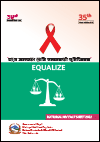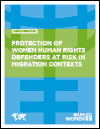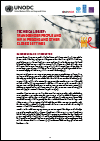What's New
Displaying results 181 - 190 of 4915

Resource | Publications,
This issue brief shares lessons and reflections on the importance of regional spaces for strengthening responses, to inform the implementation of key commitments in the Political Declaration on HIV and AIDS and the Global AIDS Strategy. These include an appreciation that convening stakeholders in regional spaces can be safer than in national spaces; regional-level discussions can foster peer-to-peer knowledge exchanges; regional level networking can lead to a network of in-country allies; and importance of regional economic communities for aligning national HIV-related laws with human rights commitments.

Resource | Publications,
This issue brief shares lessons and reflections on the importance of safe and open civic space for advancing rights-based HIV responses and informing the implementation of key commitments in the 2021 Political Declaration on HIV and AIDS and the Global AIDS Strategy. These include an understanding that early and broad engagement helps to facilitate the buy-in of key and diverse stakeholders; creating and maintaining safe, open and enabling spaces is critical for civil society to fully contribute to the HIV response; the relationships between governments and civil society are complex and require careful navigation; and capacity strengthening and sensitization of stakeholders is needed for meaningful engagement.

Resource | Fact Sheets,
Each year the annual estimates of key indicators among people living with HIV in Nepal are finalized by using AIDS Epidemic Model and Spectrum/AIM. Various survey and research data (key population size, Nepal Demographic Health Survey, trends of prevalence and behavioral data from integrated biological and behavioral surveillance surveys, behavioral information on condom use, sexual behavior, injecting practice, number of clients etc.) and program data like people on ART and PMTCT data are used as input in the analytical tools to prepare annual estimates of the status of the HIV epidemic in Nepal. The HIV epidemic in Nepal remains largely concentrated among key populations (people who inject drugs, sex workers and their clients, men who have sex with men and transgender people, male labour migrants and their wives and prison inmates).

Resource | Publications,
This document summarizes the results of the WHO-commissioned full value proposition for new tuberculosis (TB) vaccines. The assessment was commissioned to provide early evidence for national and global decision-makers involved in TB vaccine development and implementation, who include stakeholders involved in vaccine research, financing, regulation and policy-making, manufacturing, introduction and procurement. The goal is to accelerate development of effective vaccines against TB and their rapid introduction into countries.

Resource | Publications,
This guidance is intended to help policymakers develop survivor-centered programming on ending violence against women and girls that meets the needs of diverse groups of women and girls, including those who are at higher risk of experiencing violence and discrimination. It is applicable to programming across the health, justice and policing, and social services sectors, as well as coordination of these sectors, and will help improve the standard and delivery of essential services for women and girls who have experienced violence.

Resource | Publications,
Migrant women human rights defenders include women, girls, and gender-diverse persons of all ages who promote and protect the human rights of people on the move, whether they are migrants themselves or not, regardless of their migration status, and irrespective of whether they self-identify as a woman human rights defender.
These recommendations are a call to action to all stakeholders to recognize and address the risks facing migrant women human rights defenders and put in place measures to promote and protect human rights unhindered so that migrants in all their diversity can live, work, and move safely and with dignity.

Resource | Publications,
Transgender people often experience multiple and intersecting forms of discrimination, including in criminal justice systems. Evidence indicates that such marginalisation, criminalisation and discrimination can lead to greater vulnerability to and risk of long-term mental and physical health issues, including increased risk of HIV and other sexually transmitted infections, and experience of sexual assault.
This technical brief sets out guiding principles and targeted interventions aimed at supporting countries in reducing the risk of HIV infection and transmission among, and ensuring adequate and accessible health care for, transgender people deprived of liberty by State authorities in prisons and other closed settings. Policymakers and prison authorities should understand the needs of transgender people and incorporate the proposed evidence- and human rights-based interventions and international standards into their prison policies and strategies, applying them to all people in prison.

Resource | Publications,
WHO’s sentinel surveys of acquired HIV resistance to dolutegravir among people receiving dolutegravir-containing antiretroviral therapy is intended for easy and frequent implementation. Results from sentinel surveys provide insight into the prevalence and year-over-year trends of dolutegravir resistance in adults, children and adolescents receiving dolutegravir-based ART.
This sentinel method is implemented complementary to WHO-recommended methods for estimating nationally representative levels of acquired HIV drug resistance.

Resource | Guidelines,
In this guideline, WHO recommends that long-acting injectable cabotegravir (CAB-LA) may be offered as an additional HIV prevention option for people at substantial risk of HIV infection. CAB-LA is an injectable form of pre-exposure prophylaxis (PrEP) that has been shown to be highly effective at reducing the risk of HIV acquisition.
This guideline provides implementation considerations to support Member States, programme managers, policy makers, researchers, health workers, communities, and other stakeholders in the implementation of projects and programmes for CAB-LA. It also outlines critical research gaps for CAB-LA.

Resource | Publications,
This publication is primarily intended for national and local policy-makers; global, regional, country and local programme implementers; organizations working in and providers of health, HIV, mental health and other relevant services; civil society; and community-based and community-led organizations and advocates. It brings together and refers to existing HIV and mental health, psychosocial support and other service provision guidelines, recommendations and tools, including the World Health Organization (WHO) Mental Health Gap Action Programme (mhGAP) mhGAP intervention guide and mhGAP operations manual; WHO, United Nations Office on Drugs and Crime and other guidelines and tools related to substance use; and WHO consolidated guidelines, tools and resources on HIV testing, prevention, treatment and care.





